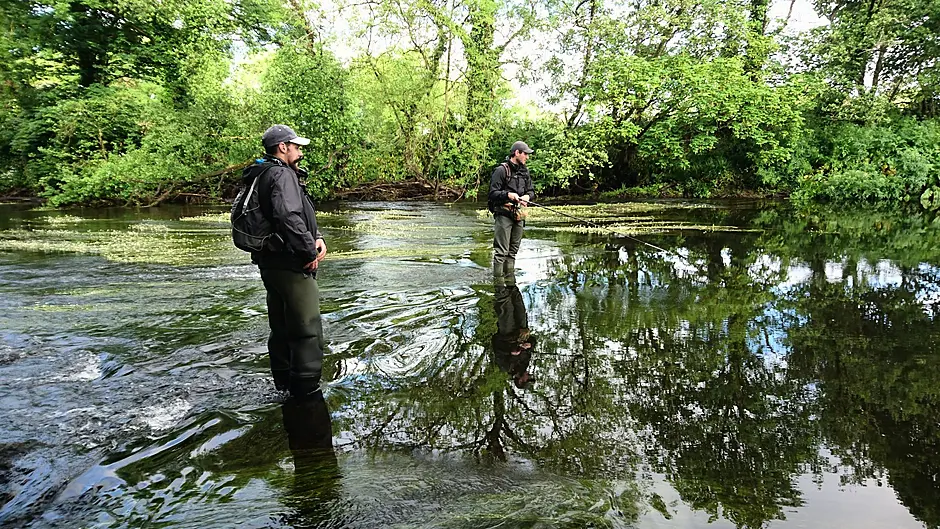It’s 100 years since the anglers of the Ilen River, which flows through Skibbereen, asked Germany to help them re-stock salmon. Six decades later, the gesture was reciprocated, as MARY McCARTHY reports
THE Ilen River is part of a river network that starts at Nowen Hill, northeast of Drimoleague, where two other neighbouring rivers rise, the Bandon and Mealagh. It goes through Drimoleague to Skibbereen, then past Old Court, and flows into the sea at Baltimore.
Barry Deane, a retired fisheries protection officer, is very aware of the river’s importance to the area. It was once a commercial river, trafficking timber and coal by boat to Fuller’s Quay in Skibbereen. And several mills were driven by it.
‘History was in the making at Madore Bridge during The Land League, where it was said that up to 5,000 people gathered below the bridge to listen to a speech by a politician who came by train to Madore station,’ said Barry.
 The river Ilen at Ballyhilty Bridge just outside Skibbereen. (Photo: Jerome Van Ryt)
The river Ilen at Ballyhilty Bridge just outside Skibbereen. (Photo: Jerome Van Ryt)
A tributary is the Acrinduff stream, which joins the Ilen River at Ballyhilty Bridge, and flows through Hollybrook. The O’Donovan family used to stop a sector by a sluice, so the area could be flooded. The last time this happened was in the 1940s. In the middle of the flooded area was a pagoda. This small building was accessed by a gondola. The family used to sail out from an area of the pier to the pagoda to find an evening’s entertainment and drink tea.
The water plant at Ballyhilty Bridge supplies drinking water from the river to Skibbereen, Church Cross, Leap, Drimoleague, and Baltimore.
‘The River Ilen Anglers Club (RIAC) has been in existence for more than 100 years. And its amenities include a disabled anglers stand at Ballyhilty Bridge, which Arthur and Nora Taylor and all the members put trojan work into providing,’ said Barry.
RIAC has 56 members, 10 juveniles, and 5 honorary members. It is about fishing, and angling and attracts a lot of tourists, according to Jerome Van Ryt, treasurer of the club.
‘Angling has been important since day one, as it was a means of providing fish, and as people progressed it became a pastime. It was controlled by the rich, and the catching of fish was lucrative, both for anglers and poachers, alike,’ said Barry.
RIAC provides access to the river in cooperation with the landowners and the members are grateful for this and appreciate it. Barry said that in the 1920s when salmon fish stocks were low in the Ilen River, the anglers came up with the idea to get fish from Germany and introduce them to the river. The Rhine River sent fish across to re-stock the Ilen River. It looked like the stocking was successful.
Over the years, with industrialisation of Germany, fish stock depleted in the Rhine. Pollution in the 1950s contributed and after a devastating flood in Holland that occurred in 1953, dams were built to the Rhine delta in Holland, offering protection from the sea.
However, it blocked the migration of fish. Salmon became completely extinct in the Rhine. ‘This was the river of Europe that always had salmon, the poor man’s food,’ said Jerome.
 An angler on Germany's Rhine. (Photo: Shutterstock).
An angler on Germany's Rhine. (Photo: Shutterstock).
Fish swim upriver for spawning. The life cycle of salmon begins as eggs in gravel in nursery streams upriver. They hatch, fry, and parr, then move to sea. The smolt stay at sea for up to four years and return to the river fully grown, where they go to the same spot where they were born to spawn themselves.
‘In the 1980s and 1990s, Germany decided to clean up their rivers, the Rhine being one. They decided to re-introduce fish stocks to the river, and with the water quality now better, they got in contact with River Ilen Anglers. The Rhine 2000 Scheme was formed. A hundred years on, the Rhine authority asked the River Ilen Anglers for their fish back,’ said Barry.
The Rhine Anglers got in contact with the fisheries board. In the year 2000, at Coomhola Hatcheries in Bantry, salmon were taken from the Ilen River. They stripped salmon eggs and unfed fry that were re-exported back to the Rhine to re-stock.
 Angler Jerome Van Ryt enjoying his time on the Ilen. (Photo: Eckhart Wagner)
Angler Jerome Van Ryt enjoying his time on the Ilen. (Photo: Eckhart Wagner)
Mark Boyden of Coomhola Salmon Trust believes that if the Ilen River salmon had even a shred of the original (and now lost) Rhine salmon DNA, it might give these stocking efforts a better chance of success.
Barry says fishing is a serious business. It can be done by both men and women. And, interestingly, the most successful anglers are women. There is a theory that it may be because some use perfume which could attract fish. Salmon, natural brown trout, eels, and sea trout are fish of the river. Angling is not only about fishing but being at one with nature, like otters, mink, and bird life. Birds on the riverside may include kingfishers, seagulls, and herons, commonly known as ‘Joney the Bogs’.
‘The Ilen River enjoys top-quality angling today,’ said Jerome, who adds that the River Ilen Anglers (riverilenanglersclub.ie) are open to attracting younger anglers to continue this beautiful heritage.
Barry loves the sentiments of Tennyson’s poem ‘The River’ – Till at last by Philip’s farm, I flow, to join the brimming river, for men may come and men may go, but I’ll go on forever.







